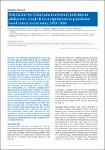Risk factors for Chlamydia trachomatis infection in adolescents: results from a representative populationbased survey in Germany, 2003–2006
Haar, Karin
Bremer, Viviane
Houareau, Claudia
Meyer, Thomas
Desai, Sarika
Thamm, Michael
Hamouda, Osamah
Infections with Chlamydia trachomatis (CT) can lead to severe sequelae; however, they are not notifiable in Germany. We tested urine samples from participants of KiGGS (German Health Interview and Examination Survey for Children and Adolescents) for CT infections and linked the results to demographic and behavioural data from 1,925 participants (girls aged 15–17 years and boys aged 16–17 years) to determine a representative prevalence of CT infection in adolescents in Germany and to assess associated risk factors. Prevalence of CT infection was 2.2% (95% CI: 1.4–3.5) in girls and 0.2% (95% CI: 0.1–0.7) in boys. CT infection in girls was associated with higher use of alcohol, marijuana and cigarettes, lower social status, oral contraceptive use, pregnancy, repeated lower abdominal pain and higher rates of doctors’ consultations within the preceding three months and consultation of gynaecologists within the last 12 months. In multiple logistic regression, we identified two predictors for CT infection: marijuana consumption often or several times within the last 12 months (F(1,164)=7.56; p
Dateien zu dieser Publikation
Keine Lizenzangabe
Verwandte Publikationen
Anzeige der Publikationen mit ähnlichem Titel, Autor, Urheber und Thema.
-
2013-02-19ZeitschriftenartikelLymphogranuloma Venereum in Men Screened for Pharyngeal and Rectal Infection, Germany Haar, Karin; Dudareva-Vizule, Sandra; Wisplinghoff, Hilmar; Wisplinghoff, Fabian; Sailer, Andrea; Jansen, Klaus; Henrich, Birgit; Marcus, UlrichTo determine prevalence of lymphogranuloma venereum among men who have sex with men in Germany, we conducted a multicenter study during 2009–2010 and found high rates of rectal and pharyngeal infection in men positive for ...
-
2011-01-24ZeitschriftenartikelPrevalence of Chlamydia trachomatis among young German adolescents, 2005–06 Desai, Sarika; Meyer, Thomas; Thamm, Michael; Hamouda, Osamah; Bremer, VivianeBackground: Chlamydia trachomatis prevalence among 12–17-year-old adolescents in Germany was determined in the present study. Methods: A random age-stratified sample of 1815 urine specimens of boys and girls was selected ...
-
2015-06-04ZeitschriftenartikelThe Proteome of the Isolated Chlamydia trachomatis Containing Vacuole Reveals a Complex Trafficking Platform Enriched for Retromer Components Aeberhard, Lukas; Banhart, Sebastian; Fischer, Martina; Jehmlich, Nico; Rose, Laura; Koch, Sophia; Laue, Michael; Renard, Bernhard Y.; Schmidt, Frank; Heuer, DagmarChlamydia trachomatis is an important human pathogen that replicates inside the infected host cell in a unique vacuole, the inclusion. The formation of this intracellular bacterial niche is essential for productive Chlamydia ...

